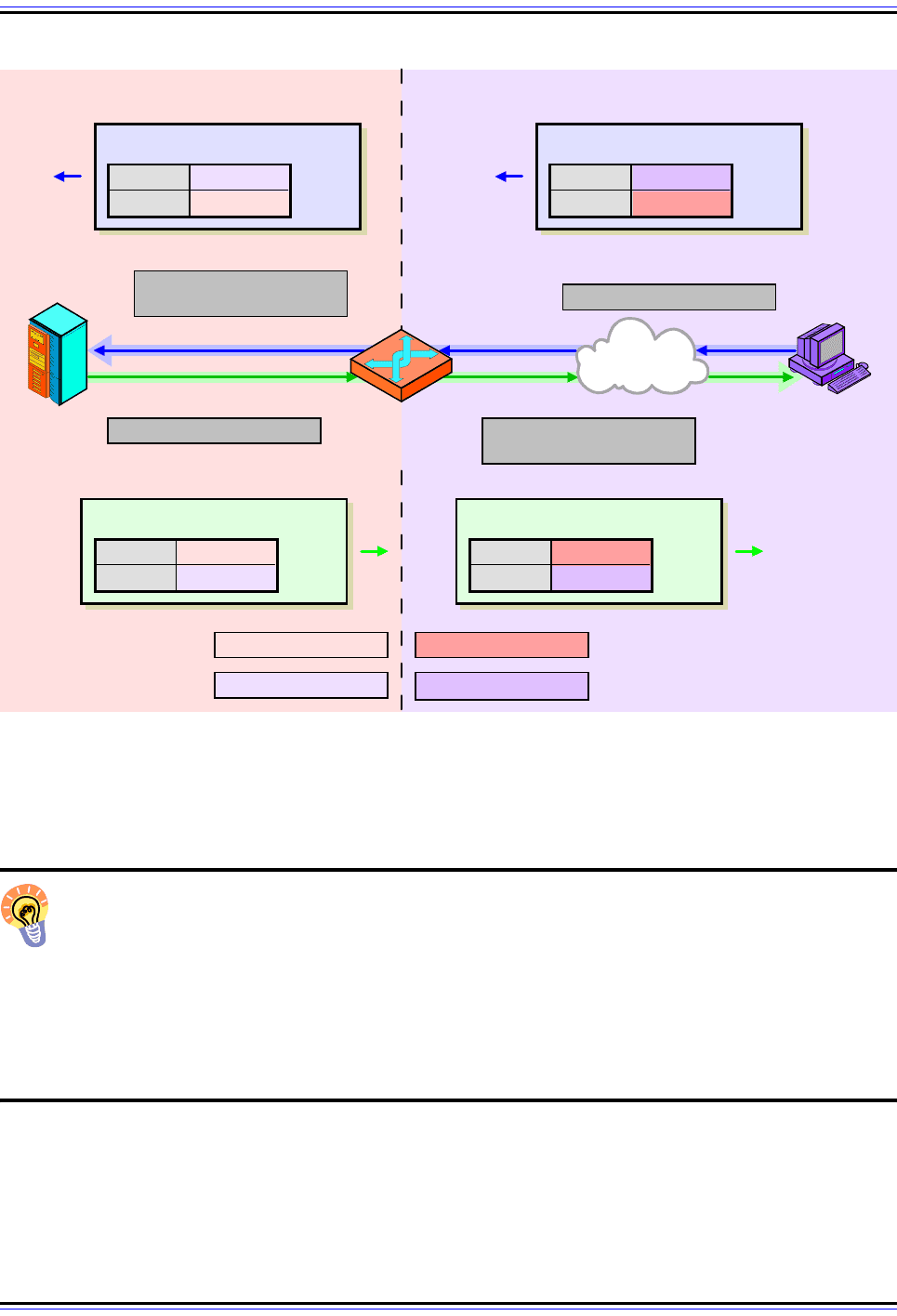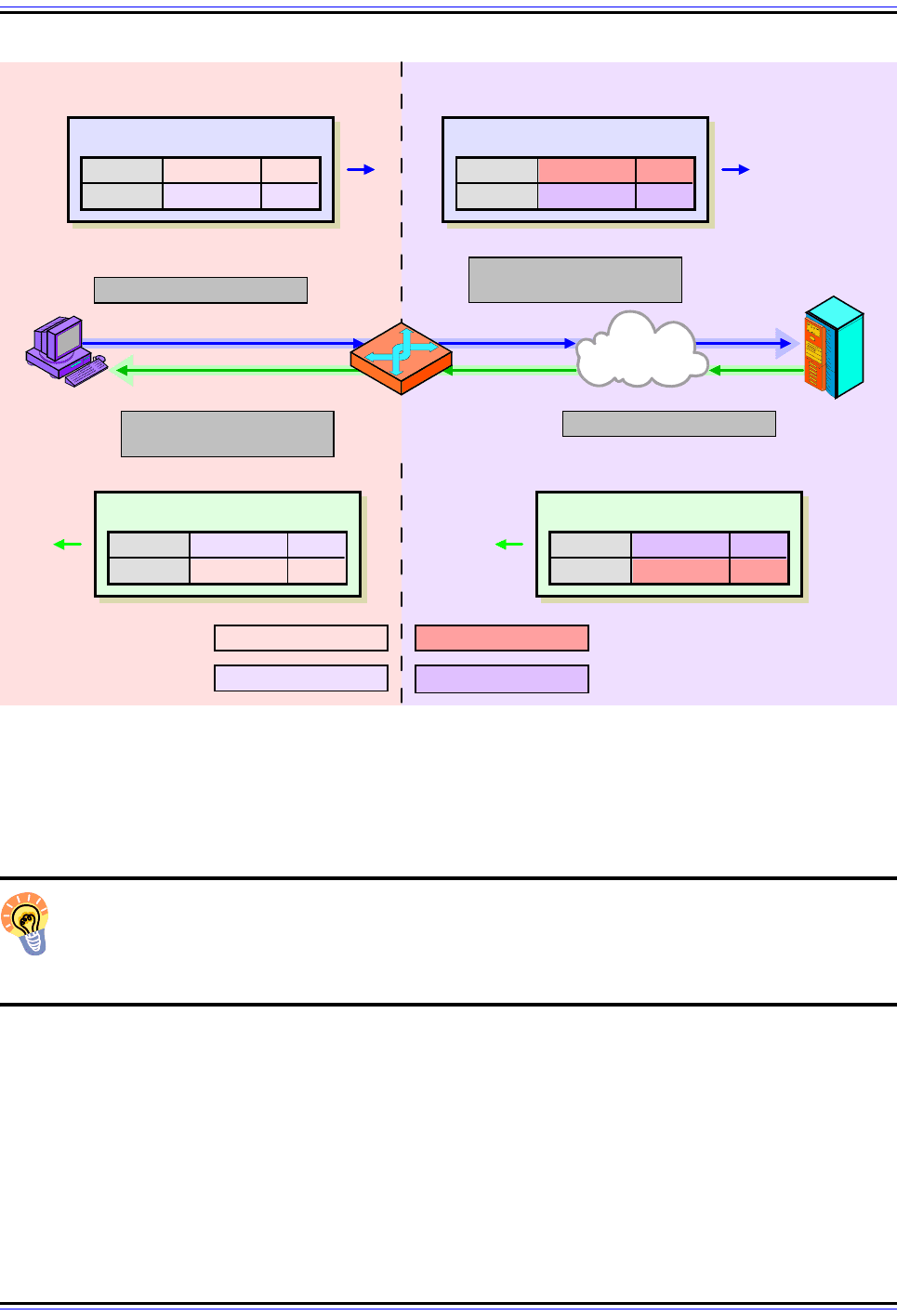Charles M. Kozierok The TCP-IP Guide
Подождите немного. Документ загружается.


The TCP/IP Guide - Version 3.0 (Contents) ` 531 _ © 2001-2005 Charles M. Kozierok. All Rights Reserved.
R2 won't know how to translate back the destination address on the incoming datagram. Of
course, this makes dynamic mapping extremely difficult: routers would have to coordinate
their address mappings.
Key Concept: In unidirectional (traditional) NAT, the NAT router translates the
source address of an outgoing request from inside local to inside global form. It then
transforms the destination address of the response from inside global to inside local.
The outside local and outside global addresses are the same in both request and reply.
IP NAT Bidirectional (Two-Way/Inbound) Operation
Traditional NAT is designed to handle only outbound transactions; clients on the local
network initiate requests and devices on the Internet send back responses. However, in
some circumstances, we may want to go in the opposite direction. That is, we may want to
have a device on the outside network initiate a transaction with one on the inside. To permit
this, we need a more capable type of NAT than the traditional version. This enhancement
goes by various names, most commonly Bidirectional NAT, Two-Way NAT and Inbound
NAT. All of these convey the concept that this kind of NAT allows both the type of trans-
action we saw in the previous topic and also transactions initiated from the outside network.
The Problem With Inbound NAT: Hidden Addresses
Performing NAT on inbound transactions is more difficult than conventional outbound NAT.
To understand why, remember that the network configuration when using NAT is inherently
asymmetric: the inside network generally knows the IP addresses of outside devices,
since they are public, but the outside network doesn't know the private addresses of the
inside network. Even if they did know them, they could never be specified as the target of
an IP datagram initiated from outside since they are not routable—there would be no way to
get them to the private network's local router.
Why does this matter? Well, consider the case of outbound NAT from device A on the inside
network to device B on the outside. The local client, A, always starts the transaction, so
device A's NAT router is able to create a mapping between device A's inside local and
inside global address during the request. Device B is the recipient of the already-translated
datagram, so the fact that device A is using NAT is hidden. Device B responds back and the
NAT router does the reverse translation without device B ever even knowing NAT was used
for device A.
Now, let's look at the inbound case. Here, device B is trying to send to device A, which is
using NAT. Device B can't send to device A's private (inside local) address. It needs device
A's inside global address in order to start the ball rolling. However, device A's NAT router
isn't proximate to device B. In fact, device B probably doesn’t even know the identity of
device A’s NAT router!

The TCP/IP Guide - Version 3.0 (Contents) ` 532 _ © 2001-2005 Charles M. Kozierok. All Rights Reserved.
Facilitating Inbound NAT Using DNS
There only two methods to resolve the hidden address problem. One is to use static
mapping for devices like servers on the inside network that need to be accessed from the
outside. When static mapping is employed, the global address of the device that is using
the static mapping will be publicly known, which solves the “where do I send my request to”
problem.
The other solution is to make use of the TCP/IP Domain Name System (DNS). As explained
in detail in the section on DNS, this protocol allows requests to be sent as names instead of
IP addresses; the DNS server translates these names to their corresponding addresses. It
is possible to integrate DNS and NAT so they work together. This process is described in
RFC 2694, DNS extensions to Network Address Translators (DNS_ALG)
.
In this technique, an outside device can in fact make use of dynamic mapping. The basic
process (highly simplified) is as follows:
1. The outside device sends a DNS request using the name of the device on the inside
network it wishes to reach. For example, it might be “www.ilikenat.com”.
2. The DNS server for the internal network resolves the “www.ilikenat.com” name into an
inside local address for the device that corresponds to this DNS entry.
3. The inside local address is passed to NAT and used to create a dynamic mapping
between the inside local address of the server being accessed from the outside, and
an inside global address. This mapping is put into the NAT router's translation table.
4. When the DNS server sends back the name resolution, it tells the outside device not
the inside local (private) address of the server being sought, but the inside global
(public) address mapped in the previous step.
Bidirectional NAT Example
Once the inside global address of the device on the inside network is known by the outside
device, the transaction can begin. Let's use the same example as in the previous topic, only
we reverse it, so that outside device 204.51.16.12 is initiating a request (and is thus now the
client) to inside device 10.0.0.207 (which is the server). Let's say that either static mapping

The TCP/IP Guide - Version 3.0 (Contents) ` 533 _ © 2001-2005 Charles M. Kozierok. All Rights Reserved.
or DNS has been used so that the outside device knows the inside global address of
10.0.0.207 is actually 194.54.21.6. Table 76 describes the transaction in detail; it is illus-
trated in Figure 113 as well.
As you can see, once the outside device knows the inside device's inside global address,
inbound NAT is very similar to outbound NAT. It just does the exact opposite translation.
Instead of modifying the source address on the outbound request and the destination on
the inbound response, the router changes the destination on the inbound request and the
source on the outbound reply.
Table 76: Operation Of Bidirectional (Two-Way/Inbound) NAT
Step
#
Description
Data-
gram
Type
Datagram
Source
Address
Datagram
Destination
Address
1
Outside Client Generates Request And Sends
To NAT Router: Device 204.51.16.12 generates
a request to the inside server. It uses the inside
global address 194.54.21.6 as the destination.
The datagram will be routed to the local router for
that address, which is the NAT router that
services the inside network where the server is
located.
Request
(from
outside
client to
inside
server)
204.51.16.12
(Outside Global)
194.54.21.6
(Inside Global)
2
NAT Router Translates Destination Address
and Sends To Inside Server: The NAT router
already has a mapping from the inside global
address to the inside local address of the server.
It replaces the 194.54.21.6 destination address
with 10.0.0.207, and performs checksum recalcu-
lations and other work as necessary. The source
address is not translated. The router then delivers
the modified datagram to the inside server at
10.0.0.207.
204.51.16.12
(Outside Local)
10.0.0.207
(Inside Local)
3
Inside Server Generates Response And
Sends Back To NAT Router: The server at
10.0.0.207 generates a response, which it
addresses to 204.51.16.12 since that was the
source of the request to it. This is then routed to
the server's NAT router.
Response
(from
inside
server to
outside
client)
10.0.0.207
(Inside Local)
204.51.16.12
(Outside Local)
4
NAT Router Translates Source Address And
Routes Datagram To Outside Client: The NAT
router sees the private address 10.0.0.207 in the
response and replaces it with 194.54.21.6. It then
routes this back to the original client on the
outside network.
194.54.21.6
(Inside Global)
204.51.16.12
(Outside Global)

The TCP/IP Guide - Version 3.0 (Contents) ` 534 _ © 2001-2005 Charles M. Kozierok. All Rights Reserved.
Key Concept: In traditional NAT, a transaction must begin with a request from a
client on the local network, but in bidirectional (two-way/inbound) NAT, it is possible
for a device on the public Internet to access a local network server. This requires the
use of either static mapping or DNS to provide to the outside client the address of the server
on the inside network. Then the NAT transaction is pretty much the same as in the unidirec-
tional case, except in reverse: the incoming request has its destination address changed
from inside global to inside local; the response has its source changed from inside local to
inside global.
Figure 113: Operation Of Bidirectional (Two-Way/Inbound) NAT
This figure is very similar to Figure 112, except that the transaction is in reverse, so please start at the upper
right and go counter-clockwise. Translated addresses are shown in bold. Table 76 contains a complete expla-
nation of the four steps. Refer to Figure 111 for an explanation of address types.
Source 204.51.16.12
Destination 194.54.21.6
Request
Source 204.51.16.12
Destination
10.0.0.207
Translated Request
Source
194.54.21.6
Destination 204.51.16.12
Translated Response
Source 10.0.0.207
Destination 204.51.16.12
Response
1. Client Sends Request
2. NAT Router Translates
Destination Address
NAT
Router
3. Server Sends Response
4. NAT Router Translates
Source Address
Internet
Local Network
("Inside")
Public Internet
("Outside")
Inside Local Address
Outside Local Address
Inside Global Address
Outside Global Address
Server
10.0.0.207
Server
204.51.16.12

The TCP/IP Guide - Version 3.0 (Contents) ` 535 _ © 2001-2005 Charles M. Kozierok. All Rights Reserved.
IP NAT Port-Based ("Overloaded") Operation: Network Address Port
Translation (NAPT) / Port Address Translation (PAT)
Both traditional NAT and bidirectional NAT work by swapping inside network and outside
network addresses as needed to allow a private network to access a public one. For each
transaction, there is a one-to-one mapping between the inside local address of a device on
the private network, and the inside global address that represents it on the public network.
We can use dynamic address assignment to allow a large number of private hosts to share
a small number of registered public addresses.
However, there is a potential snag here. Consider our earlier NAT example, where 250
hosts share 20 inside global (public) addresses. If 20 hosts already have transactions in
progress, what happens when the 21st tries to access the Internet? There aren't any inside
global addresses available for it to use, so it won't be able to.
Using Ports to Multiplex Private Addresses
Fortunately, there is a mechanism already built into TCP/IP that can help us alleviate this
situation. The two TCP/IP transport layer protocols, TCP and UDP, both make use of
additional addressing components called ports. The port number in a TCP or UDP message
helps identify individual connections between two addresses. It is used to allow many
different applications on a TCP/IP client and server to talk to each simultaneously, without
interference. For example, you use this capability when you open multiple browser windows
to access more than one Web page on the same site at the same time. This sharing of IP
addresses amongst many connections is called multiplexing. The section on TCP and UDP
ports describes all of this in much more detail.
Now, let's come back to NAT. We are already translating IP addresses as we send
datagrams between the public and private portions of the internetwork. What if we could
also translate port numbers? Well, we can! The combination of an address and port
uniquely identifies a connection. As a datagram passes from the private network to the
public one, we can change not just the IP address but also the port number in the TCP or
UDP header. The datagram will be sent out with a different source address and port. The
response will come back to this same address and port combination (called a socket) and
can be translated back again.
This method goes by various names. Since it is a technique whereby we can have multiple
inside local addresses share a single inside global address, it is called overloading of an
inside global address, or alternately, just overloaded NAT. More elegant names that better
indicate how the technique works include Port-Based NAT, Network Address Port Trans-
lation (NAPT) and Port Address Translation (PAT).
Whatever its name, the use of ports in translation has tremendous advantages. It can allow
all 250 hosts on our private network to use only 20 IP addresses—and potentially even
fewer than that. In theory you could even have all 250 share a single public IP address at
once! You don't want to share so many local hosts that you run out of port numbers, but
there are thousands of port numbers to choose from.

The TCP/IP Guide - Version 3.0 (Contents) ` 536 _ © 2001-2005 Charles M. Kozierok. All Rights Reserved.
Port-based NAT of course requires a router that is programmed to make the appropriate
address and port mappings for datagrams as it transfers them between networks. The
disadvantages of the method include this greater complexity, and also more potential
compatibility issues (such as with applications like FTP) since we must now watch for port
numbers at higher layers and not just IP addresses.
Key Concept: Port-based or “overloaded” NAT is an enhancement of regular NAT
that allows a large number of devices on a private network to simultaneously “share”
a single inside global address by changing the port numbers used in TCP and UDP
messages.
Port-Based NAT Example
The operation of NAPT/PAT is very similar to the way regular NAT works, except that port
numbers are also translated. For a traditional outbound transaction, the source port number
is changed on the request at the same time that the source address is modified; the desti-
nation port number is modified on the response with the destination address.
Let's consider again the example we looked at in the topic on Traditional NAT, but this time
in a PAT environment. Device 10.0.0.207 was one of 250 hosts on a private network
accessing the WWW server at 204.51.16.12. Let's say that because PAT is being used, to
save money all 250 are sharing a single inside global address, 194.54.21.7, instead of a
pool of 20. The transaction would proceed as described in Table 77 and diagrammed in
Figure 114.

The TCP/IP Guide - Version 3.0 (Contents) ` 537 _ © 2001-2005 Charles M. Kozierok. All Rights Reserved.
Table 77: Operation Of Port-Based (“Overloaded”) NAT
Step
#
Description
Data-
gram
Type
Datagram
Source
Address:Port
Datagram
Destination
Address:Port
1
Inside Client Generates Request And Sends
To NAT Router: Device 10.0.0.207 generates
an HTTP request to the server at 204.51.16.12.
The standard server port for WWW is 80, so the
destination port of the request is 80; let's say
the source port on the client is 7000. The
datagram is sent to the NAT-capable router that
connects the organization's internal network to
the Internet.
Request
(from
inside
client to
outside
server)
10.0.0.207:7000
(Inside Local)
204.51.16.12:80
(Outside Local)
2
NAT Router Translates Source Address And
Port And Sends To Outside Server: The NAT
router realizes that 10.0.0.207 is an inside local
address and knows it must substitute an inside
global address. Here though, there are multiple
hosts sharing the single inside global address
194.54.21.7. Lets say that port 7000 is already
in use for that address by another private host
connection. The router substitutes the inside
global address and also chooses a new source
port number, say 7224, for this request. The
destination address and port are not changed.
The NAT router puts the address and port
mapping into its translation table. It sends the
modified datagram out, which arrives at the
server at 204.51.16.12.
194.54.21.7:7224
(Inside Global)
204.51.16.12
(Outside Global)
3
Outside Server Generates Response And
Sends Back To NAT Router: The server at
204.51.16.12 generates an HTTP response. It
of course has no idea that NAT was involved; it
sees an address of 194.54.21.7 and port of
7224 in the request sent to it, so it sends back
to that address and port.
Response
(from
outside
server to
inside
client)
204.51.16.12:80
(Outside Global)
194.54.21.7:7224
(Inside Global)
4
NAT Router Translates Destination Address
And Port And Delivers Datagram To Inside
Client: The NAT router sees the address
94.54.21.7 and port 7224 in the response that
arrived from the Internet. It consults its trans-
lation table and knows this datagram is
intended for 10.0.0.207, port 7000. This time
the destination address and port are changed
but not the source. The router then delivers the
datagram back to the originating client.
204.51.16.12:80
(Outside Local)
10.0.0.207:7000
(Inside Local)

The TCP/IP Guide - Version 3.0 (Contents) ` 538 _ © 2001-2005 Charles M. Kozierok. All Rights Reserved.
Key Concept: In port-based NAT, the NAT router translates the source address and
port of an outgoing request from inside local to inside global form. It then transforms
the destination address and port of the response from inside global to inside local.
The outside local and outside global addresses are the same in both request and reply.
One other issue related to NAPT/PAT is worth mentioning: it assumes that all traffic uses
either UDP or TCP at the transport layer. While generally the case, this may not always be
true. If there is no port number, port translation cannot be done and the method will not
work.
Figure 114: Operation Of Port-Based (“Overloaded”) NAT
This figure is very similar to Figure 112, except that the source and destination port numbers have been
shown, since they are used in this type of NAT. Translated addresses/ports are in bold. Table 77 contains a
complete explanation of the four steps in port-based NAT. Refer to Figure 111 for an explanation of address
types.
Source 10.0.0.207 7000
Destination 204.51.16.12 80
Request
Source
194.54.21.7 7224
Destination 204.51.16.12 80
Translated Request
Source 204.51.16.12 80
Destination
10.0.0.207 7000
Translated Response
Source 204.51.16.12 80
Destination 194.54.21.7 7224
Response
1. Client Sends Request
2. NAT Router Translates
Source Address & Port
NAT
Router
3. Server Sends Response
4. NAT Router Translates
Destination Address & Port
Internet
Client
10.0.0.207
Server
204.51.16.12
Local Network
("Inside")
Public Internet
("Outside")
Inside Local Address
Outside Local Address
Inside Global Address
Outside Global Address

The TCP/IP Guide - Version 3.0 (Contents) ` 539 _ © 2001-2005 Charles M. Kozierok. All Rights Reserved.
IP NAT "Overlapping" / "Twice NAT" Operation
All three of the versions of NAT discussed so far—traditional, bidirectional and port-based—
are normally used to connect a network using private, non-routable addresses to the public
Internet, which uses unique, registered, routable addresses. With these kinds of NAT, there
will normally be no overlap between the address spaces of the inside and outside network,
since the former are private and the latter public. This enables the NAT router to be able to
immediately distinguish inside addresses from outside addresses just by looking at them.
In the examples we've seen so far, the inside addresses were all from the RFC 1918 block
10.0.0.0. These can't be public Internet addresses so the NAT router knew any address
referenced by a request from the inside network within this range was a local reference
within the inside network. Similarly, any addresses outside this range are easy to identify as
belonging to the “outside world”.
Cases With Overlapping Private and Public Address Blocks
There are circumstances however where there may indeed be an overlap between the
addresses used for the inside network, and the addresses used for part of the outside
network. Consider the following cases:
☯ Private Network To Private Network Connections: Our example network using
10.0.0.0 block addresses might want to connect to another network using the same
method. This situation might occur if two corporations merge and happened to be
using the same addressing scheme (and there aren't that many private IP blocks, so
this isn't that uncommon).
☯ Invalid Assignment of Public Address Space To Private Network: Some networks
might have been set up not using a designated private address block but rather a
block containing valid Internet addresses. For example, suppose an administrator
decided that the network he was setting up “would never be connected to the Internet”
(ha!) and numbered the whole thing using 18.0.0.0 addresses, which belong to the
Massachusetts Institute of Technology (MIT). Then later, this administrator's short-
sightedness would backfire when the network did indeed need to be connected to the
'net.
☯ “Stale” Public Address Assignment: Company A might have been using a particular
address block for years that was reassigned or reallocated for whatever reason to
company B. Company A might not want to go through the hassle of renumbering their
network, and would then keep their addresses even while Company B started using
them on the Internet.
What these situations all have in common is that the inside addresses used in the private
network overlap with addresses on the public network. When a datagram is sent from
within the local network, the NAT router can't tell if the intended destination is within the
inside network or the outside network. For example, if we want to connect host 10.0.0.207
in our private network to host 10.0.0.199 in a different network, and we put 10.0.0.199 in the
destination of the datagram and send it, how does the router know if we mean 10.0.0.199
on our own local network or the remote one? For that matter, we might need to send a

The TCP/IP Guide - Version 3.0 (Contents) ` 540 _ © 2001-2005 Charles M. Kozierok. All Rights Reserved.
request to 10.0.0.207 in the other private network, our own address! Take the network that
was numbered with MIT's address block. How does the router know when a datagram is
actually being sent to MIT as opposed to another device on the private network?
Dealing With Overlapping Blocks By Using NAT Twice
The solution to this dilemma is to use a more sophisticated form of NAT. The other versions
we have seen so far always translate either the source address or the destination address
as a datagram passes from the inside network to the outside network or vice versa. To cope
with overlapping addresses, we must translate both the source address and the destination
address on each transition from the inside to the outside or the other direction. This
technique is called Overlapping NAT in reference to the problem it solves, or “Twice NAT”
due to how it solves it. (Incidentally, despite the latter name, regular NAT is not called “Once
NAT”.)
Twice NAT functions by creating a set of mappings not only for the private network the NAT
router serves, but also for the overlapping network (or networks) that conflict with the inside
network's address space. In order for this to function, Twice NAT relies on the use of the
TCP/IP Domain Name System (DNS), just like bidirectional NAT. This lets the inside
network send requests to the overlapping network in a way that can be uniquely identified.
Otherwise, the router can't tell what overlapping network our inside network is trying to
contact.
“Overlapping” / “Twice” NAT Example
Let's try a new example. Suppose our network has been improperly numbered so that it is
not in the 10.0.0.0 private block but in the 18.0.0.0 block used by MIT. A client on our private
network, 18.0.0.18, wants to send a request to the server “www.twicenat.mit.edu”, which
has the address 18.1.2.3 at MIT. Our client can't just make a datagram with 18.1.2.3 as the
destination and send out, as the router will think it's on the local network and not route it.
Instead, 18.0.0.18 uses a combination of DNS and NAT to get the outside device address
as follows:
1. The client on our local network (18.0.0.18) sends a DNS request to get the address of
“www.twicenat.mit.edu”.
2. The (Twice-NAT compatible) NAT router serving our local network intercepts this DNS
request. It then consults its tables to find a special mapping for this outside device.
Let's say, it is programmed to translate “www.twicenat.mit.edu” into the address
172.16.44.55. This is a private non-routable RFC 1918 address.
3. The NAT router returns this value, 172.16.44.55 to the source client, which uses it for
the destination.
Once our client has the translated address, it initiates a transaction just as before. NAT now
will perform both translation of the inside devices and the outside devices as well. The
outside device address must be translated because the inside device is using
172.16.44.55, which isn't a valid address for the server it is trying to reach. The inside
